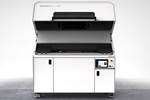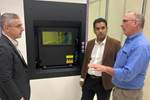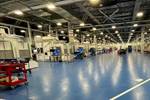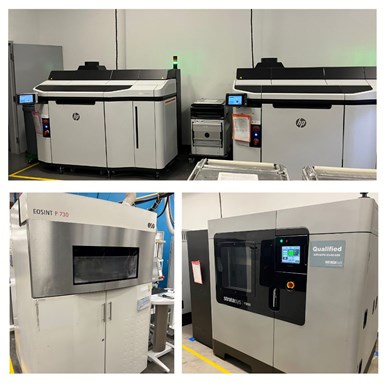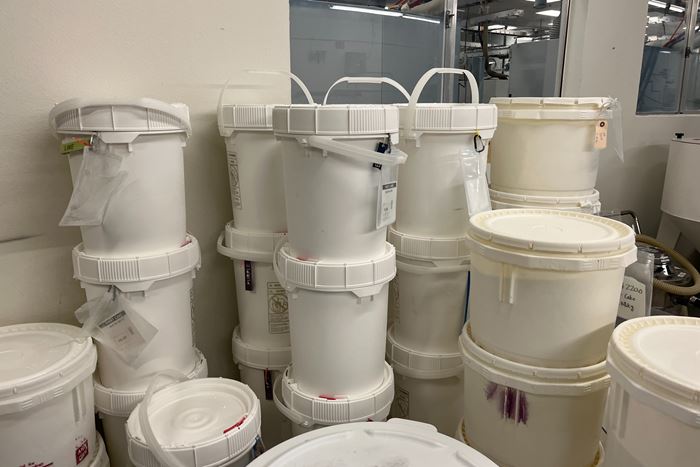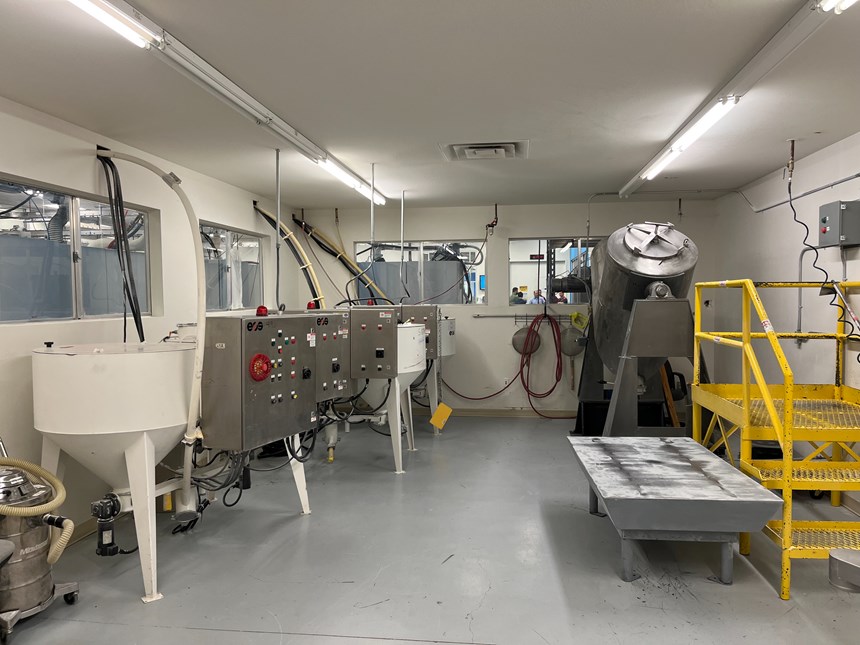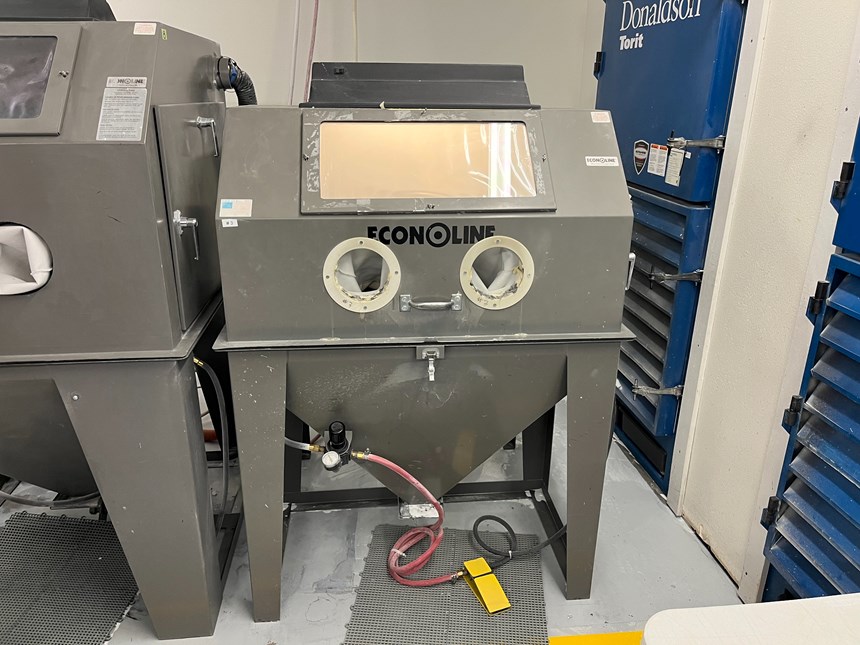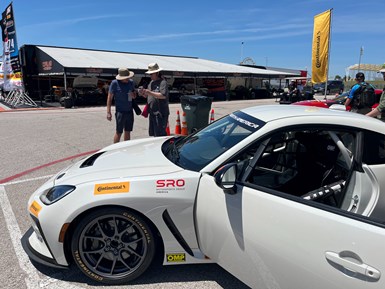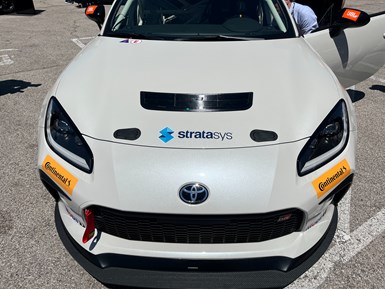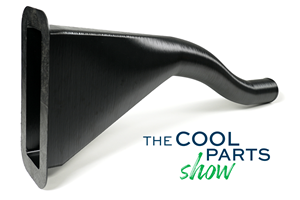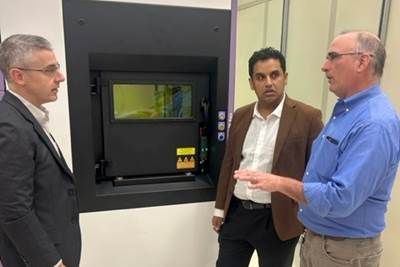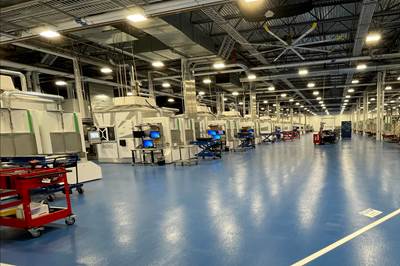I recently had the chance to visit the Stratasys Direct Manufacturing site in Belton, Texas, where the company performs a variety of contract production. To follow: A guided tour through the additive capabilities of the facility and postprocessing resources that support them.
The Stratasys Direct Manufacturing facility at Belton has a variety of technologies for mass production via AM.
Additively manufactured parts are produced for a variety of industries at Belton, as the facility is defense and aerospace certified (respectively, ITAR registered and equipped with the latest revisions of AS9100 certification). However, the Belton site also caters to the automotive sector, along with performing medical and dental production.
During the shop visit, I previewed several of the automotive parts Stratasys 3D printed for Toyota race cars racing at The Circuit of Americas Racetrack.
According to Stratasys Chief Industrial Business Officer, Richard Garrity, the Belton manufacturing facility is equipped not only for mass producing parts via 3D printing, but also functions as a supplier for customers from the beginning of a design idea to testing the completed parts before large orders are made, ensuring optimized quality and functionality.
“Employing additive manufacturing as a useful tool means encompassing hardware, surface, and software solutions for the entire process, from start to finish,” Garrity says.
Technology at the Belton Site
This means a variety of systems and technology applications are needed. This site emphasizes polymer manufacturing.
The 3D printing processes featured at Belton include Fused Deposition Modeling (FDM), HP’s Multi Jet Fusion (MJF), Selective Laser Sintering (SLS) on EOS large frame machines and Stratasys’ patented technology, Selective Absorption Fusion (SAF). SAF technology is leveraged for the production of larger quantities of end-use parts.
SAF printer sales began in 2021 on the heels of COVID-19. Stratasys says the technology is designed to be cost accessible but generate parts at production-level quantity.
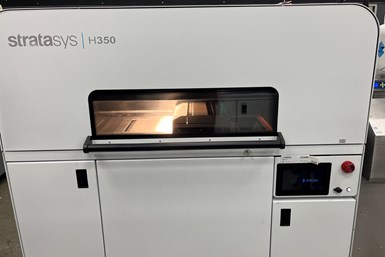
Stratasys’ most recent 3D printing technology, SAF enables quick means of mass production for end-use parts.
SAF functions as a polymer powder bed fusion process using infrared absorption fluid to bond particles together into layers which build up into parts. This is followed by exposure to infrared energy, which works to fuse and seal the part.
SAF technology employs easy-to-use analytics to promote optimized builds, Garrity says, and the physical footprint of the machine itself is small relative to machines with comparable outut. At present, there are six SAF machines working at the Belton manufacturing site.
Depicted on top, some of the 10 MJF printers from HP, on the bottom left, one of eight large frame EOS machines, and bottom right, one of 14 Stratasys FDM printers currently running at the Belton facility.
FDM, another technology for which the company is known, has 14 fully functioning machines in the facility.
But the site is not limited to one company’s equipment. Along with 10 HP MJF printers at Belton, the eight EOS large frame SLS machines are joined by 31 operational SLS standard frame machines from 3D Systems, with seven more potentially coming from a counterpart Stratasys facility in Valencia, California.
To complement the various printers, the Belton site is equipped with technologies for a multitude of postprocessing needs for surfaces (paint, dye, different finishes) and fine detail work (by means of three CNC machines as well as human benchwork).
With diverse additive machines and corresponding technologies on the floor, Stratasys is cautious with the materials used on certain machines and implements internal work instructions for cleaning them to ensure production efficiency. These processes include but are not limited to:
- Adhering to strict protocols when reintroducing leftover powder.
- Sorting powder and optimizing powder performance with various sifting machines.
- Organizing and storing certain powders in the Powder Mixing Room for safety.
- Using specific powders with corresponding machines to prevent unwanted interactions and issues with cleaning post-builds.
Material Tidiness
Facility Functionality and Flow
So how does the additive facility function from within?
Stratasys is focused on space optimization. Clear paths guide the way to different sectors of the facility floor. While full, the company says there is plenty of room for maneuvering machines to accommodate current technologies as well as those that may come from Valencia.
The previously mentioned machines each have a neck of the woods throughout the facility and the SAF, SLS and MJF machines each have their own wing. But the site’s organization also has to address the question:
Which powders can run on which machine(s)?

A peek inside the quality laboratory. Intended for material testing, this isolated space enables experimentation and optimization of materials at the facility.
Stratasys has an isolated, enclosed powder mixing room as well as a quality laboratory for material testing. Inside the powder mixing room, over 12 materials are managed routinely, often using a V mixer.
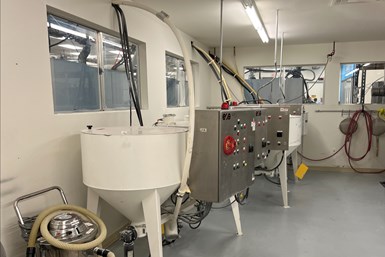
The powder in these storage units is being fed directly to the corresponding SLS machines sitting just outside the powder mixing room.
Two of the SLS machines sit just outside of the powder mixing room and are connected through an intricate channel system to the complementary feedstock housed in the mixing room ensuring the correct powder is fed into the machines for these sensitive applications.
Machines? Check. Materials? Check. Storage and testing space? Check.
Postprocessing is the last stop along the way of this textual tour. Stratasys offers various options for finishing end-use parts, from sanding and bead blasting, to a fully automated DyeMansion finishing system. Near this sector resides a detail and design area where end-use parts are painted, and some finishes might be added by human hand.
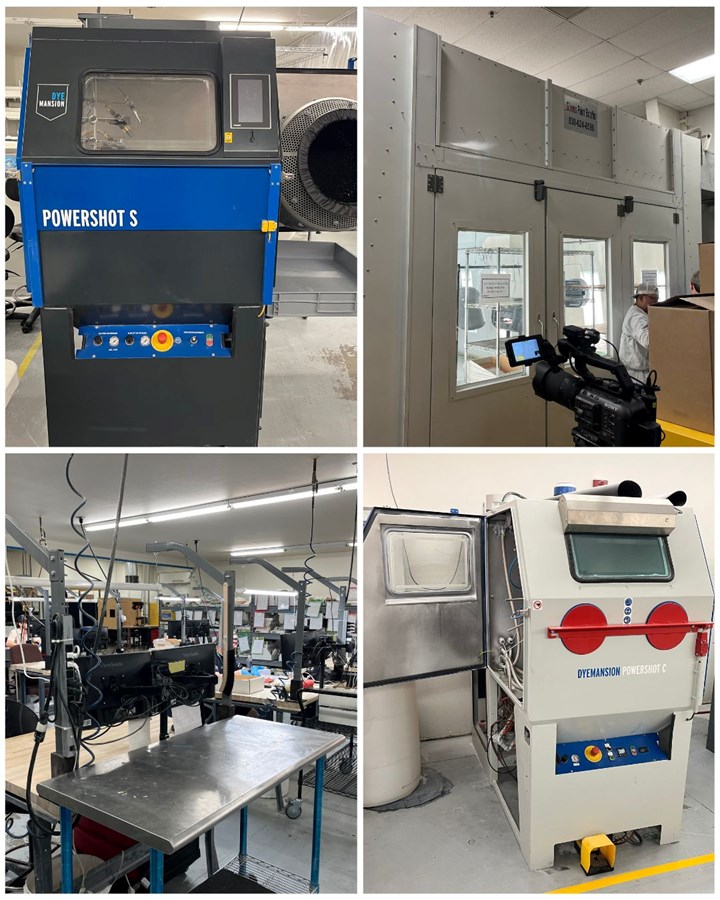
The Stratasys Direct Manufacturing site in Belton, Texas has the capacity for postprocessing in a variety of ways. Seen here are different DyeMansion machines, fine detail stations, and a paint lab for additional details post-print.
Parts Produced at the One Stop Shop
Stratasys’ main goal with its Belton facility is to accommodate and accelerate each step of the production process for customers. One such customer is Toyota and I got to see firsthand a few of the different parts Stratasys 3D printed for the Toyota Racing Development (TRD) race cars (specifically the GR86 models).
The Toyota GR86 race car model currently has about 30 different 3D printed parts per car, with more to come.
In total, there are around 30 different 3D printed parts on each race car. I saw two — up close and personal — both on and off the race car. FDM technology was the primary choice for printing most of the race car parts due to the strength of the nylon CF10 material, though a few parts were printed with powder on SAF technology.
One of these exceptions using SAF was the 3D printed door handle bezels on the inside of the driver’s side door.
The 3D printed door handle on the Toyota GR86 race car is found on the inside of the driver’s side door in black.
Complete with postprocessing (detailing for the logo and the black coating it received), this part was manufactured from start to finish at the Belton facility.
The second part I saw were the hood vents for each race car, which were 3D printed using FDM. This integral attachment allows the hot air built up inside the car to exit via the hood for efficient engine cooling and aerodynamics. The hood vent, or “scoop” provides the engine with cooler air, thus increasing the engine’s ability to sustain more power.
The 3D printed hood vent (located directly above the Stratasys logo) allows hot air trapped inside the race car to exit the vehicle, simultaneously cooling the engine and improving aerodynamics.
The FDM F900 machine was selected to print the hood vents as this technology prints using the Ultem 9085 black material needed to meet the heat tolerance requirement.
Furthermore, this technology accommodated the desired part size, as Toyota did not want any bond joint lines present in the part. The F900 is the only FDM printer at the Belton site that can print parts this size in one single piece (using the Ultem 9085 material).
As of now, there are 31 identical, fully functioning Toyota race cars of this model, with more being built. Each month, more parts are being designed by TRD engineers and moving forward, and it is likely SAF will be chosen to satisfy strength, temperature and surface finish requirements for new parts, the company says.
According to Nelson Cosgrove, TRD chief engineer, these cars are each built from scratch under a compressed period of time. AM proves itself useful in decreasing lead times while generating quality, end-use parts on demand.
“AM accelerates pushing the envelope and is helpful for obtaining real-time feedback as we continue to build,” says Cosgrove.
In this way, he says, the option of having parts made quickly when and where they are needed is changing the racing industry.
Stratasys aims to support this advance: The ability to pick and choose the 3D technology best for the application, all housed in a collective location makes for faster and more optimized prints — helping this customer, and others, win their various races.
Related Content
Aircraft Ducts 3D Printed in Composite Instead of Metal: The Cool Parts Show #68
Eaton’s new reinforced PEKK, tailored to aircraft applications, provides a cheaper and faster way to make ducts compared to formed aluminum.
Read MoreConcept Sneaker Boasts One-Piece 3D Printed TPU Construction
The Reebok x Botter Concept Sneaker Engineered by HP premiered at Paris Fashion Week, hinting at manufacturing possibilities for the future of footwear.
Read More6 Trends in Additive Manufacturing Technology at IMTS 2024
3D printers are getting bigger, faster and smarter. But don’t overlook the other equipment that the AM workflow requires, nor the value of finding the right supplier.
Read MoreQ&A With Align EVP: Why the Invisalign Manufacturer Acquired Cubicure, and the Future of Personalized Orthodontics
Align Technology produces nearly 1 million unique aligner parts per day. Its acquisition of technology supplier Cubicure in January supports demand for 3D printed tooling and direct printed orthodontic devices at mass scale.
Read MoreRead Next
Stratasys Acquires Outstanding Stake In Xaar 3D
3D printers powered by Xaar 3D’s Selective Absorption Fusion (SAF) technology are said to provide faster, more versatile and economical alternatives to traditional manufacturing methods.
Read MoreNew Zeda Additive Manufacturing Factory in Ohio Will Serve Medical, Military and Aerospace Production
Site providing laser powder bed fusion as well as machining and other postprocessing will open in late 2023, and will employ over 100. Chief technology officer Greg Morris sees economic and personnel advantages of serving different markets from a single AM facility.
Read MoreThe Arrival of the AM Factory: How Proprietary Processes Deliver Production 3D Printing
Various recent articles report on companies using internally developed technology to equip factories and deliver on the promise of AM for production.
Read More


